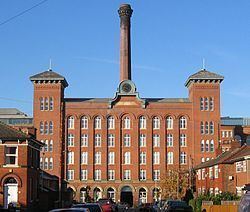Alternative names Reddish Mill Opened 1865 | Current tenants various Renovated 1999 | |
 | ||
Further ownership Fine Cotton Spinners' Association by merger (1898)John Myer's Mail Order Warehouse (1950s) Current owners Heaton and Houldsworth Property Company Similar Reddish, Victoria Mill, St Elisabeth's Church, Reddish South railway st, Hat Works | ||
Houldsworth mill reddish stockport mancheester
Houldsworth Mill, also known as Reddish Mill, is a former mill in built in 1865 in Reddish, Stockport, Greater Manchester, England (grid reference SJ895935). Designed by Abraham Stott, it was constructed for Henry Houldsworth, a prominent mill owner at the time. It is currently a Grade II* listed building.
Contents
- Houldsworth mill reddish stockport mancheester
- Map of Houldsworth Mill Houldsworth St Stockport SK5 6DS UK
- History
- After cotton
- Architecture
- Restoration
- References
Map of Houldsworth Mill, Houldsworth St, Stockport SK5 6DS, UK
History
Reddish mill was built by Stott and Sons for William Houldsworth, it opened in 1865, it covers 64 acres (260,000 m2), and employed 454 workers. In 1898 it amalgamated with the Fine Cotton Spinners Association. The mill had 136,692 spindles and at one time spun counts of 700 and 800, but normally 80s to 250s.
After cotton
Cotton production at Houldsworth Mill ceased in the 1950s. The mill was sold to a mail-order catalogue company, John Myers, and was used principally as a warehouse. In the late 1960s the building was expanded with a five-storey extension to the rear of the north end of the mill. This was built of glass and concrete in the style of the period. Mail-order trading ceased in the 1970s, and the mill was sold. It was divided into separate business units, but most of the building remained vacant and it fell into a state of disrepair.
Architecture
The 1865 mill consists of two five storeyed blocks of 18 bays, with a narrower 9 bay central block for warehousing and offices. The central block has two italianate stair towers and carries a central clock. The floors have become wider to accommodate the larger mules of the period. All floors are fireproof, with transverse vaults. The detached engine house used horizontal shafts that connected to vertical shafts in each spinning block. The chimney was octagonal, on a plinth with a highly embellished oversailer. In the early 20th century this was replaced with separate inverted compound engines for each block with external rope races for rope drives.
Restoration
The pilot study for restoration was part funded by English Heritage. The refurbishment was funded by:
This mill was converted by Stephenson Bell architects. It provides 70 shared ownership apartments for social housing provider Northern Counties Housing Association, start-up units for emerging high-technology and arts based businesses with commercial and leisure uses at the lower floors to provide active frontages.
